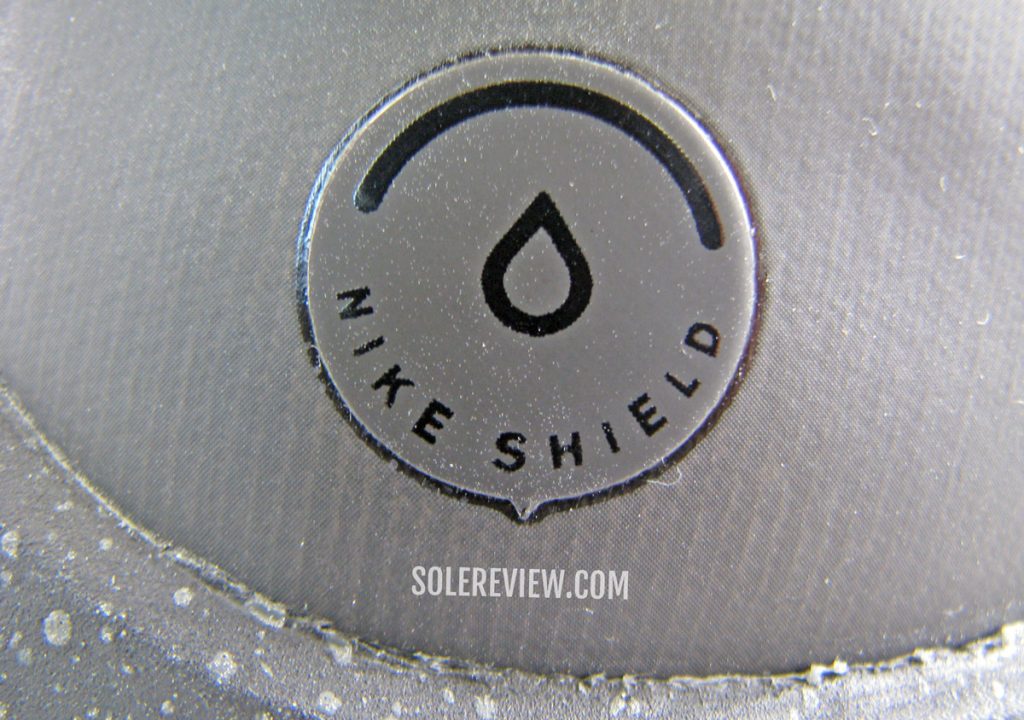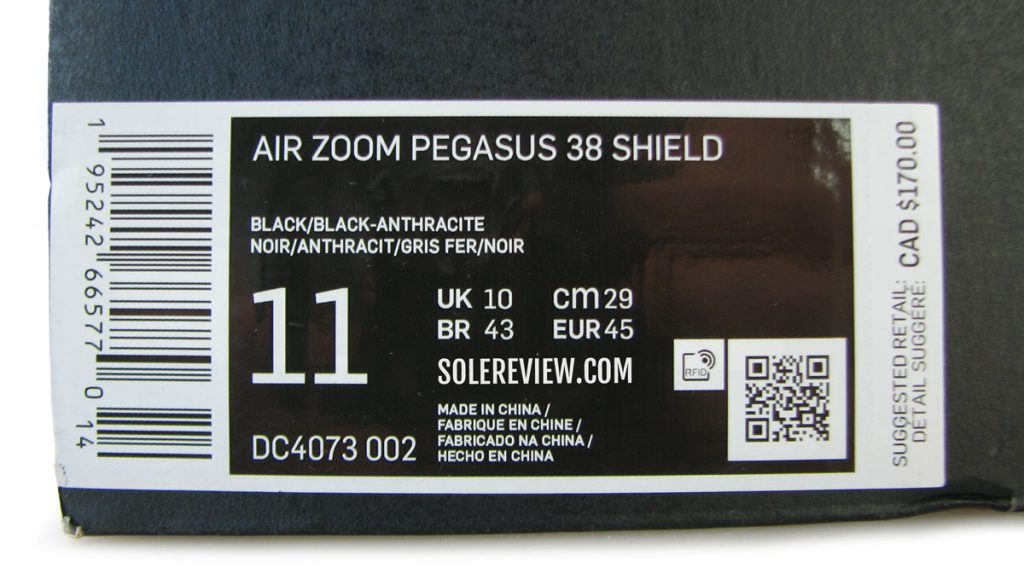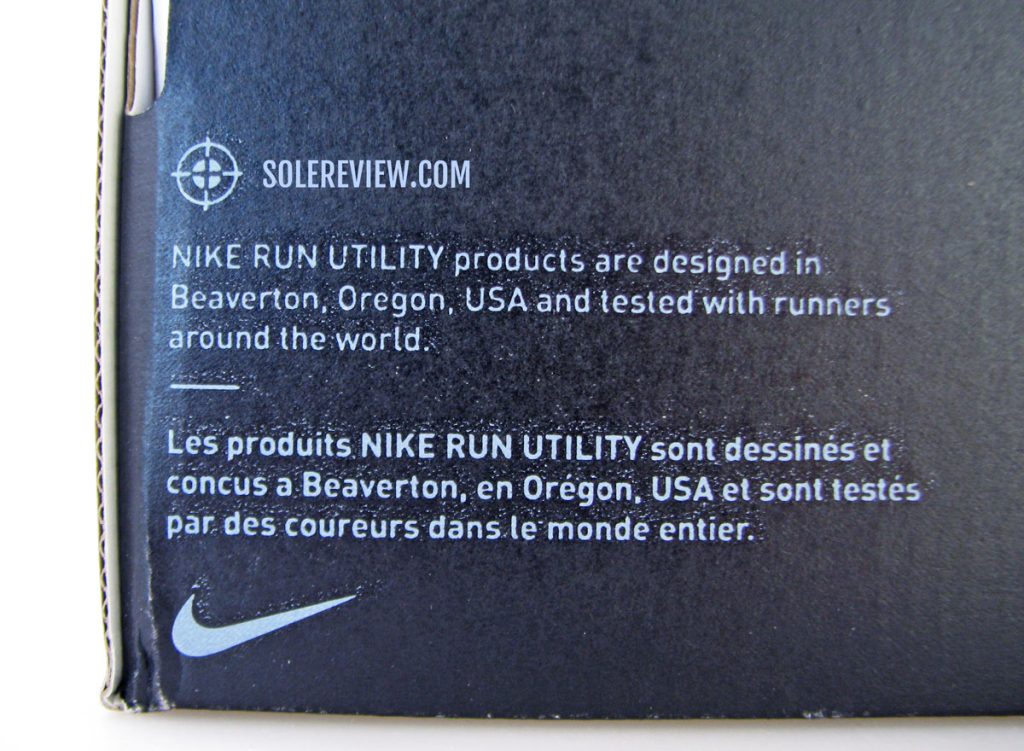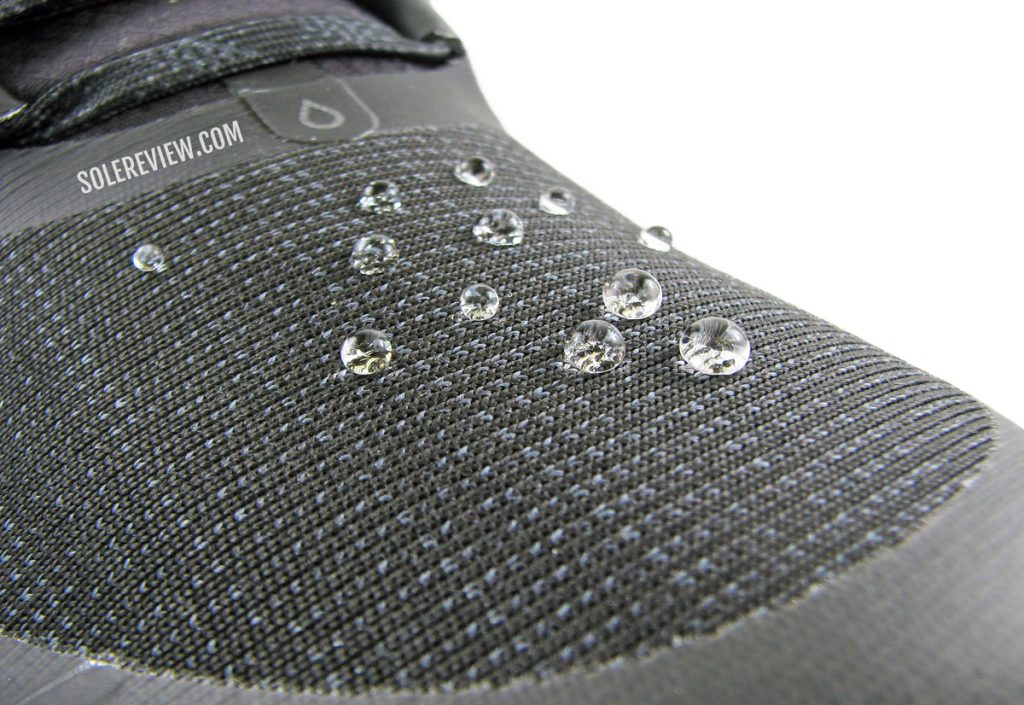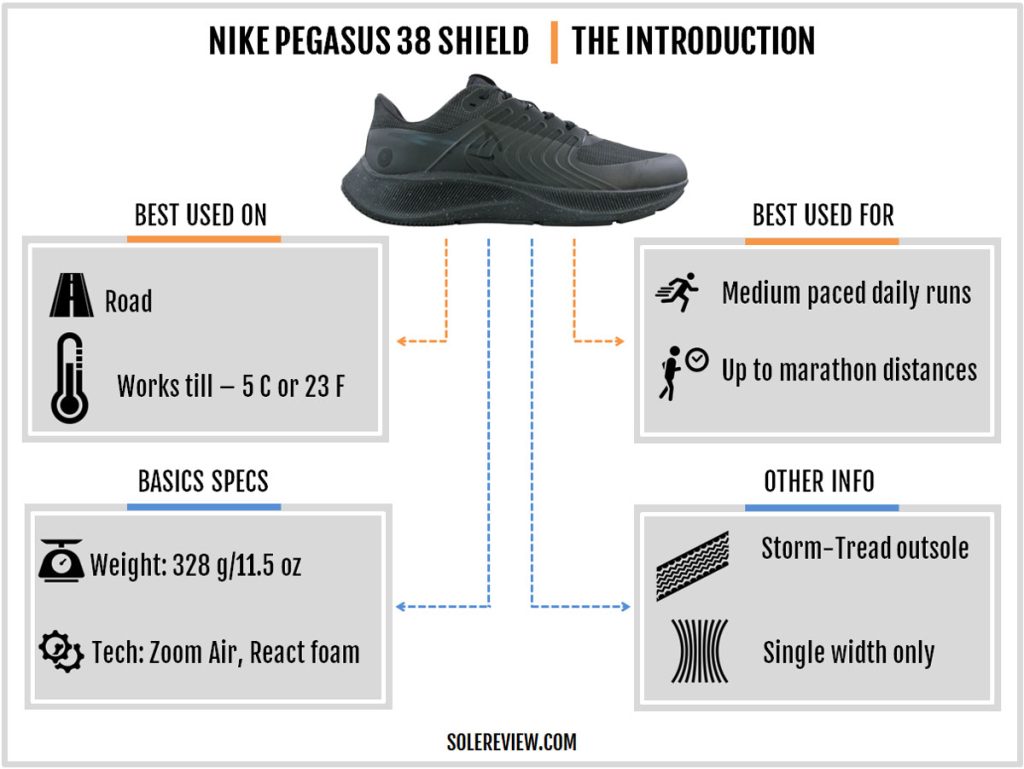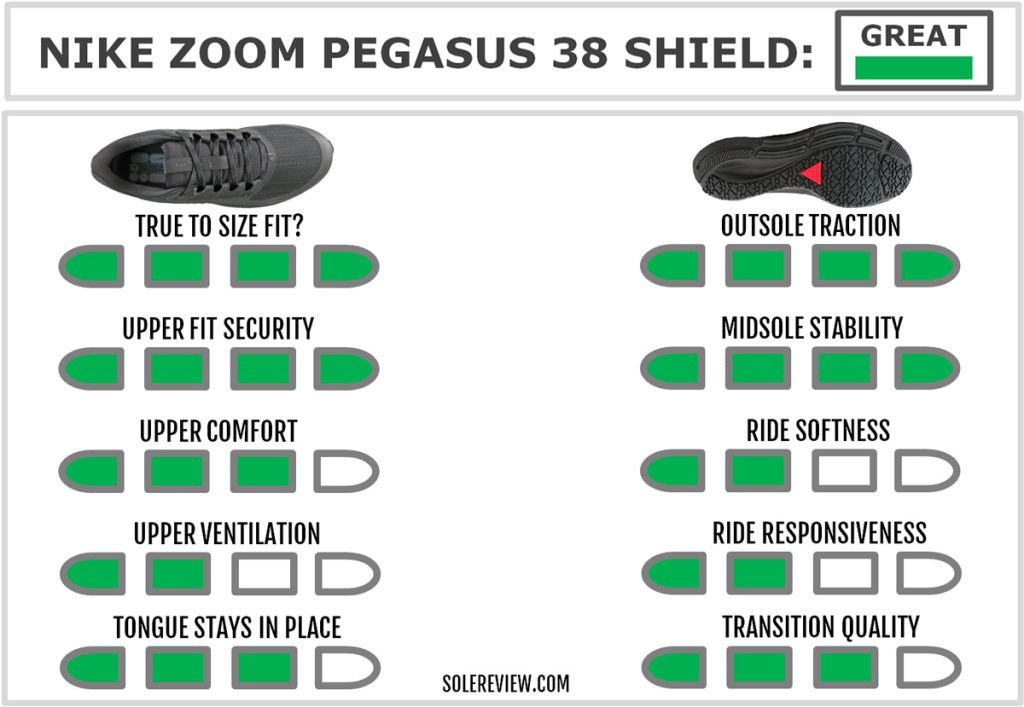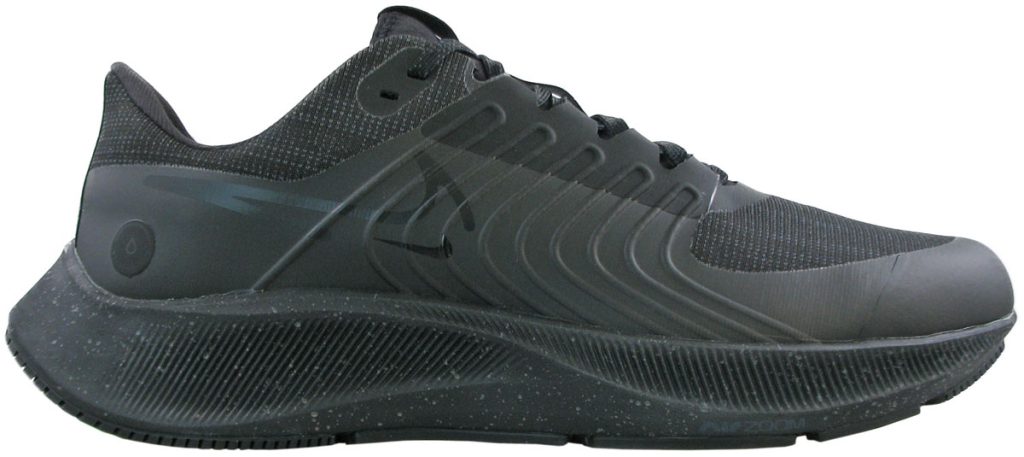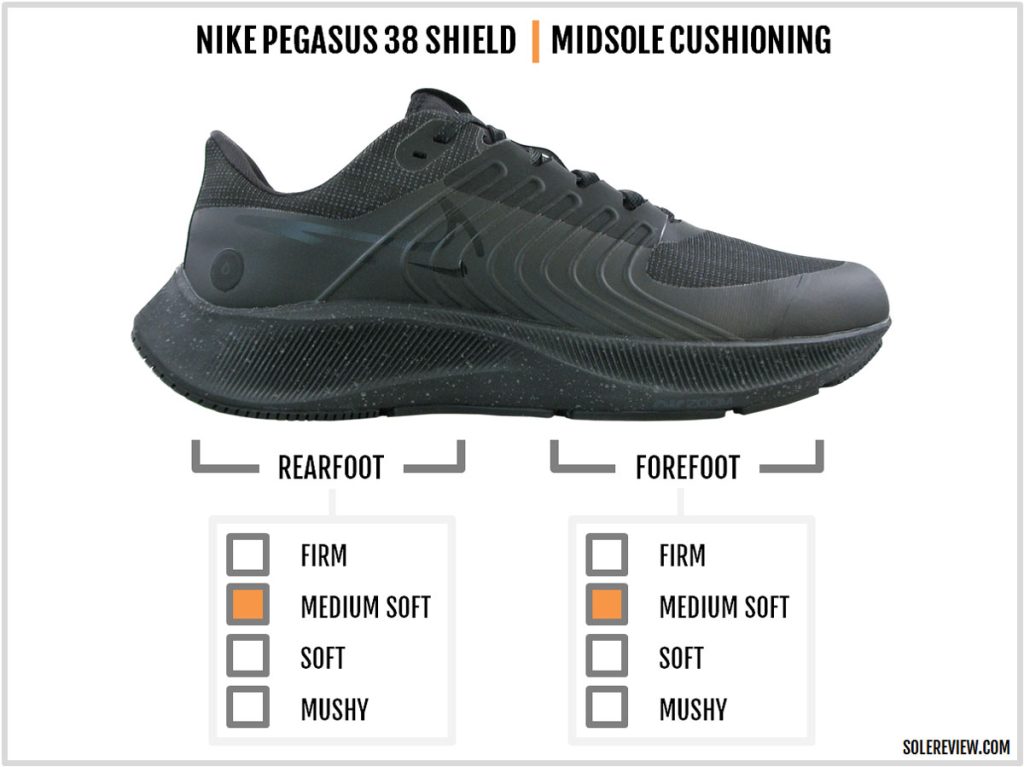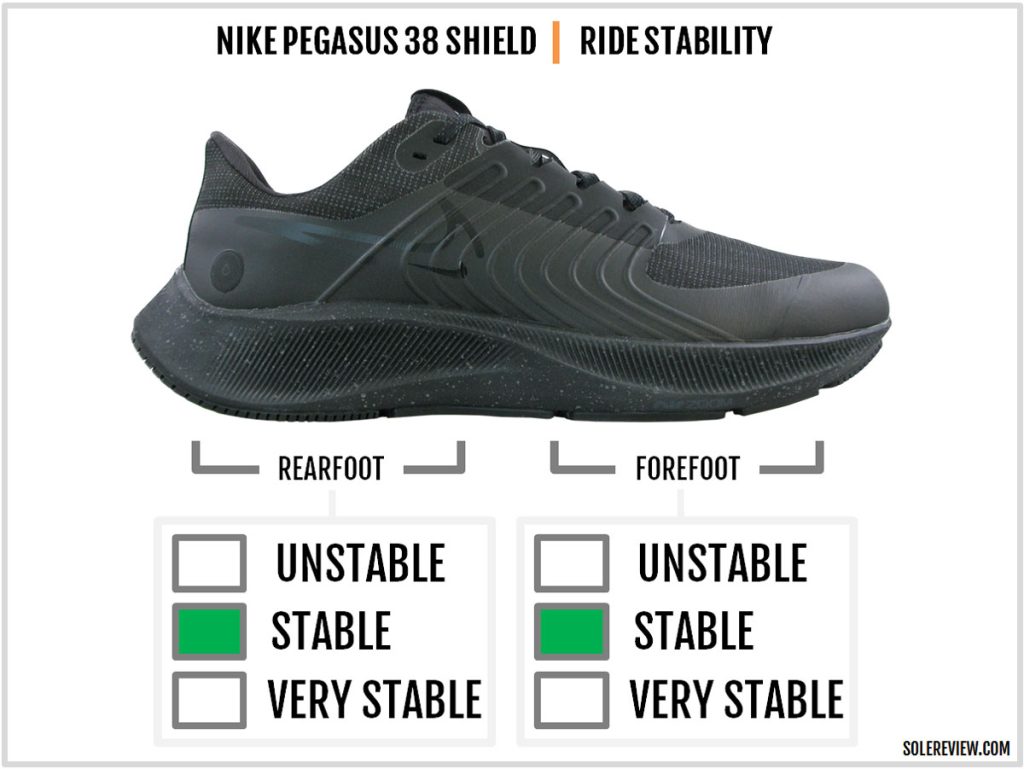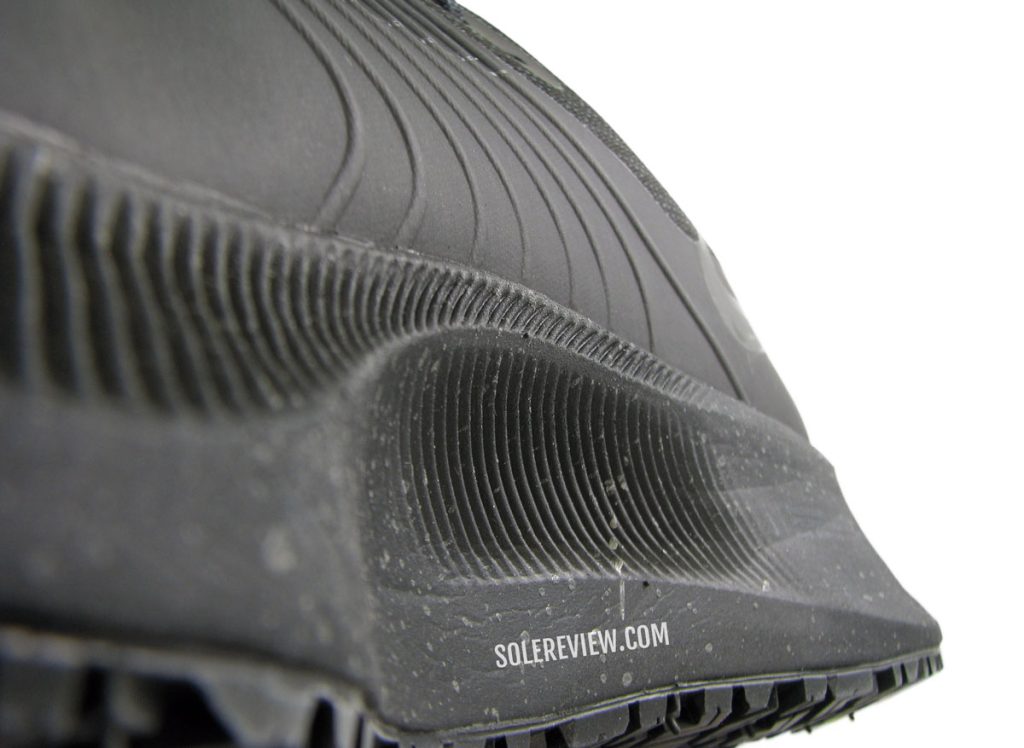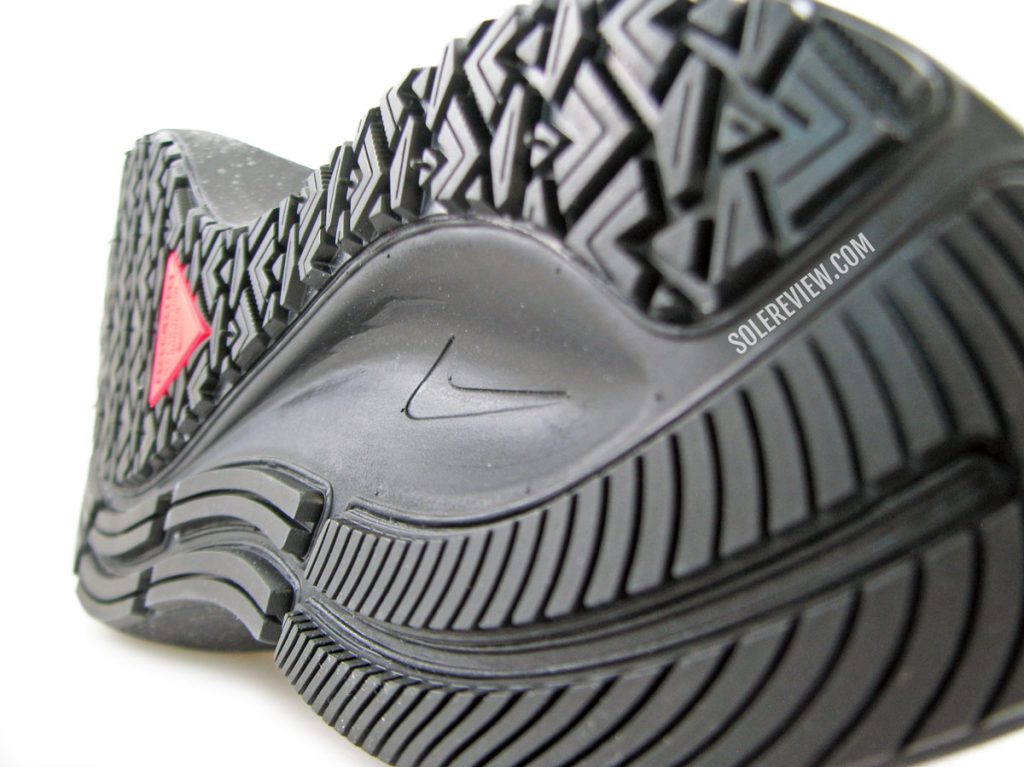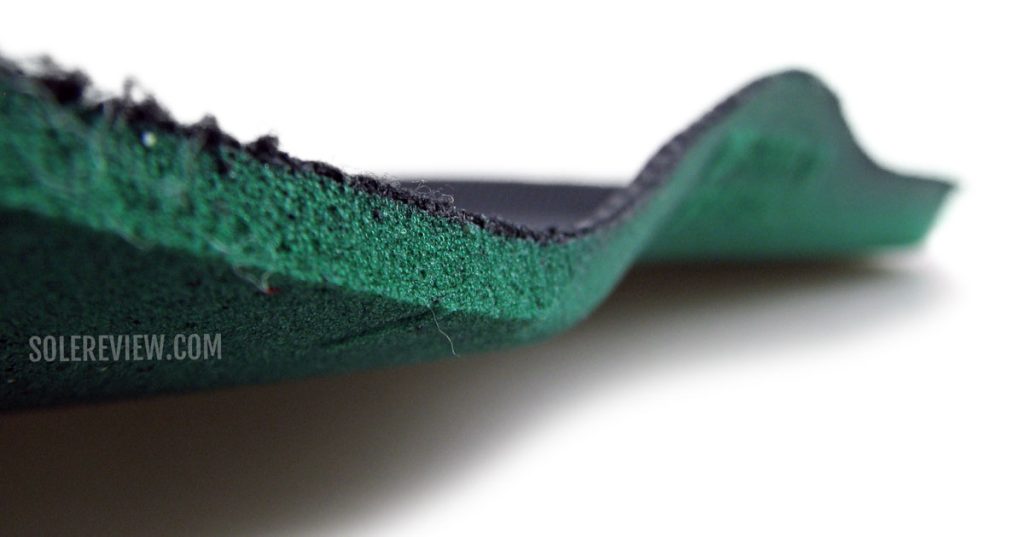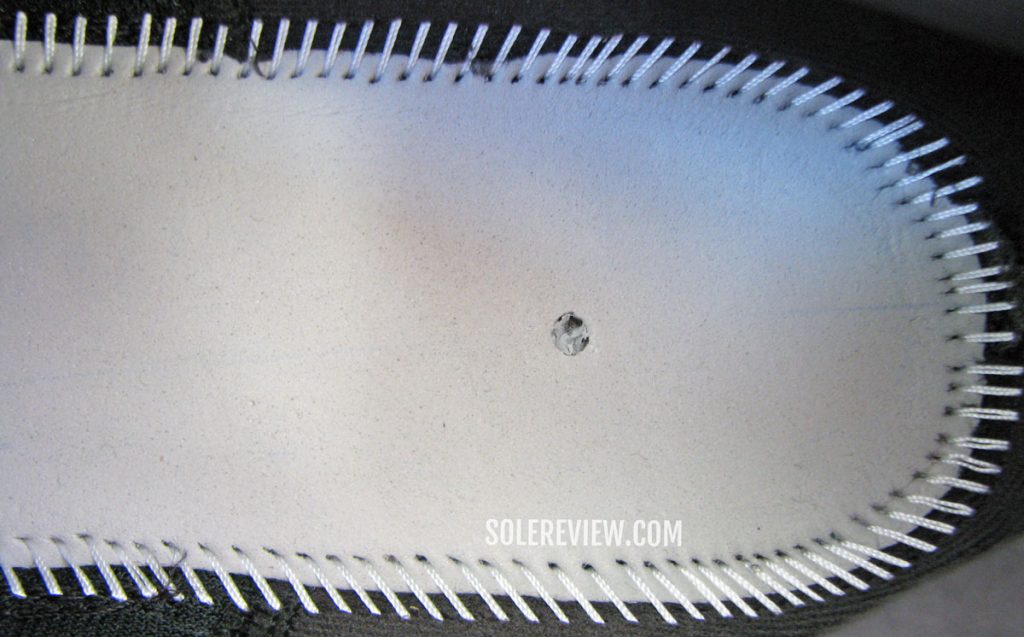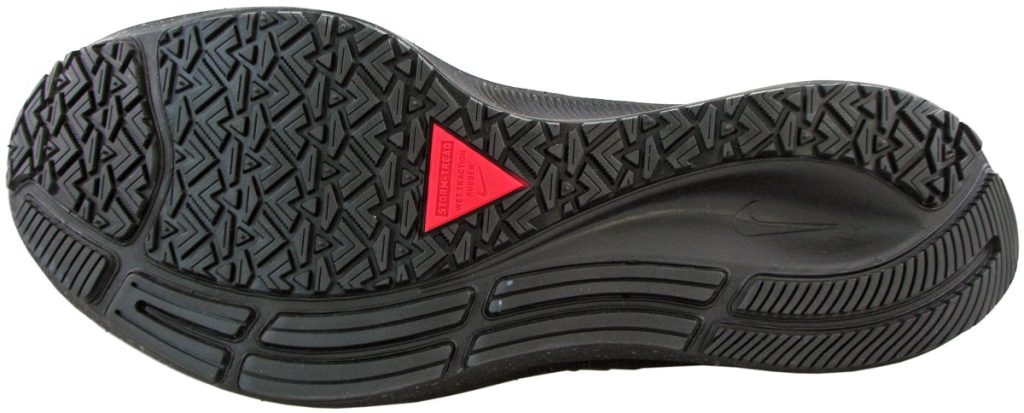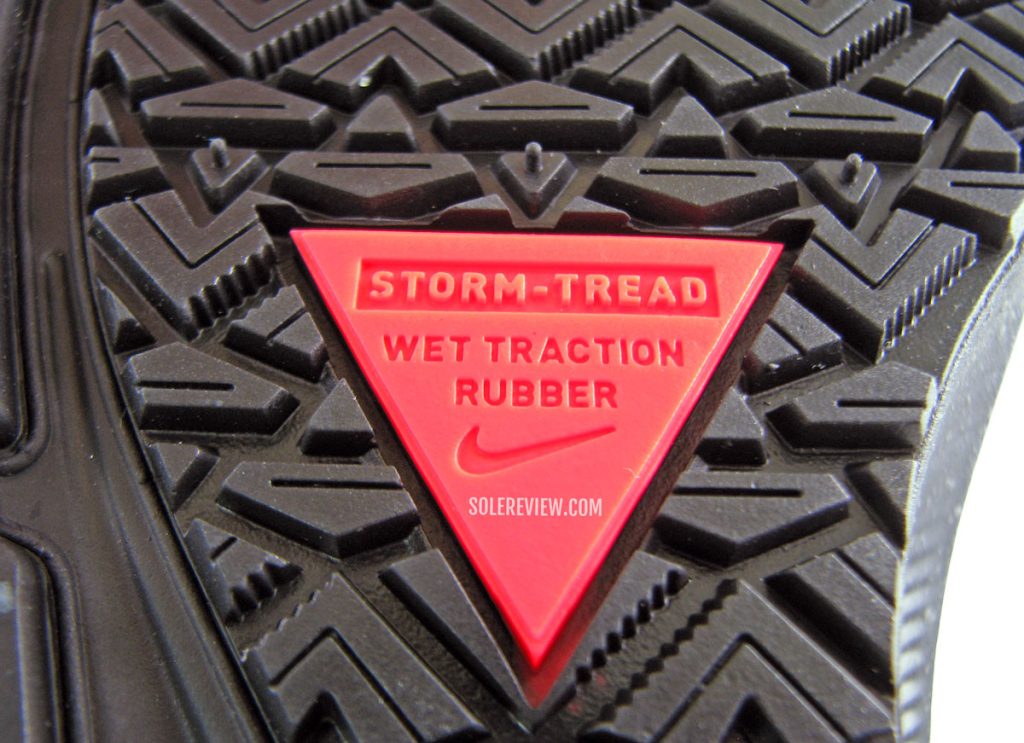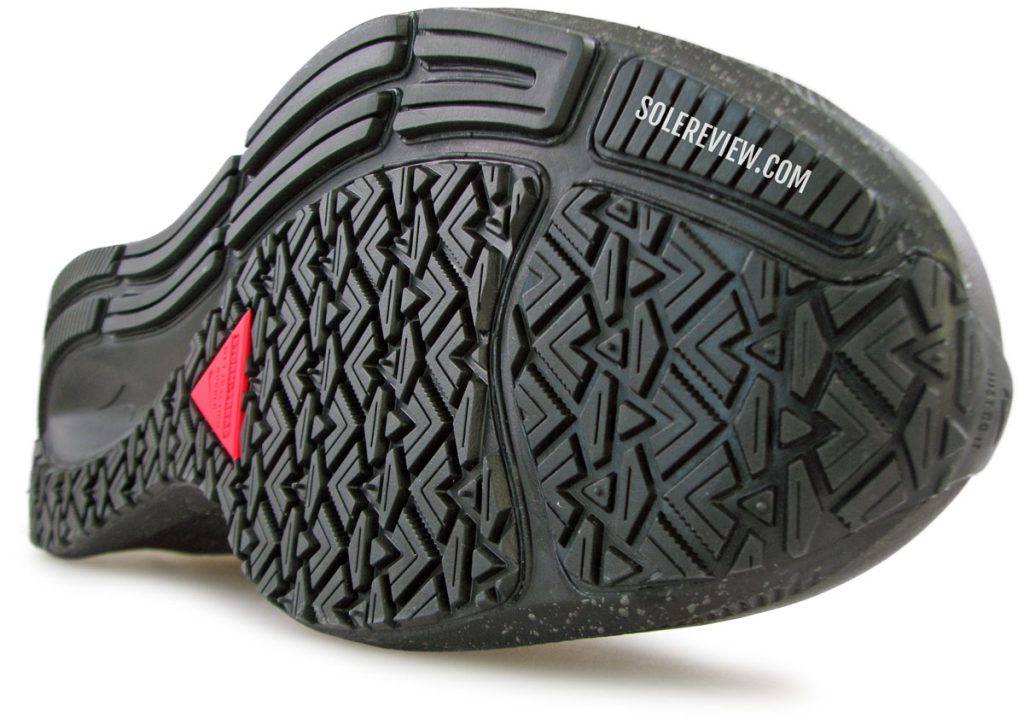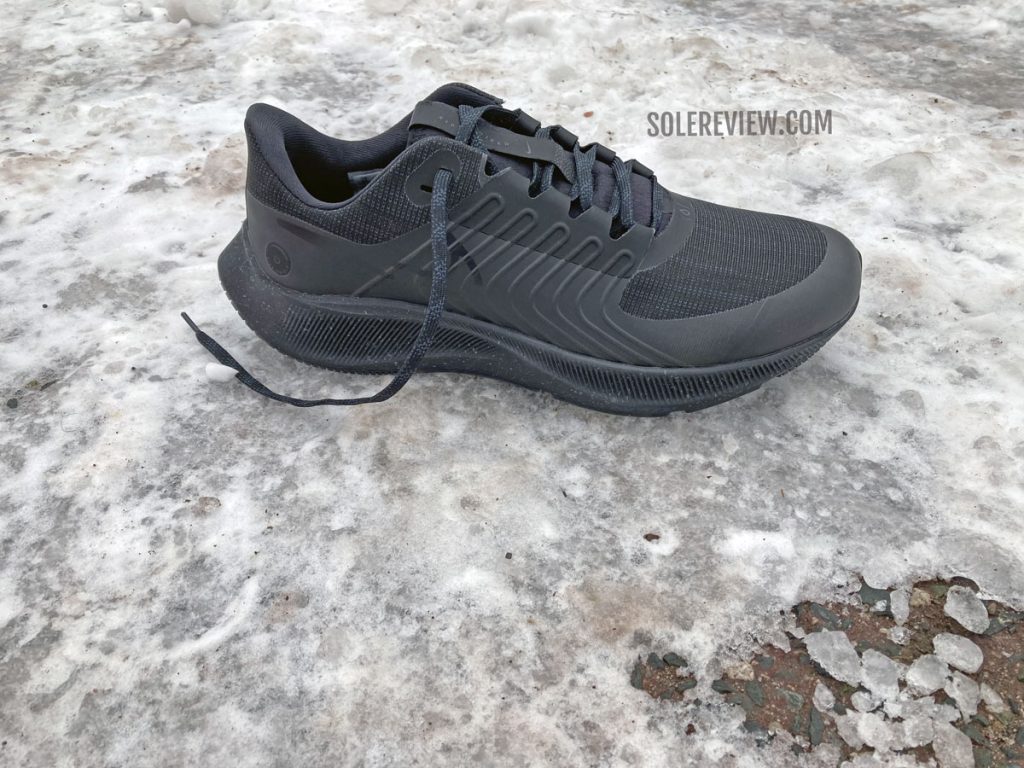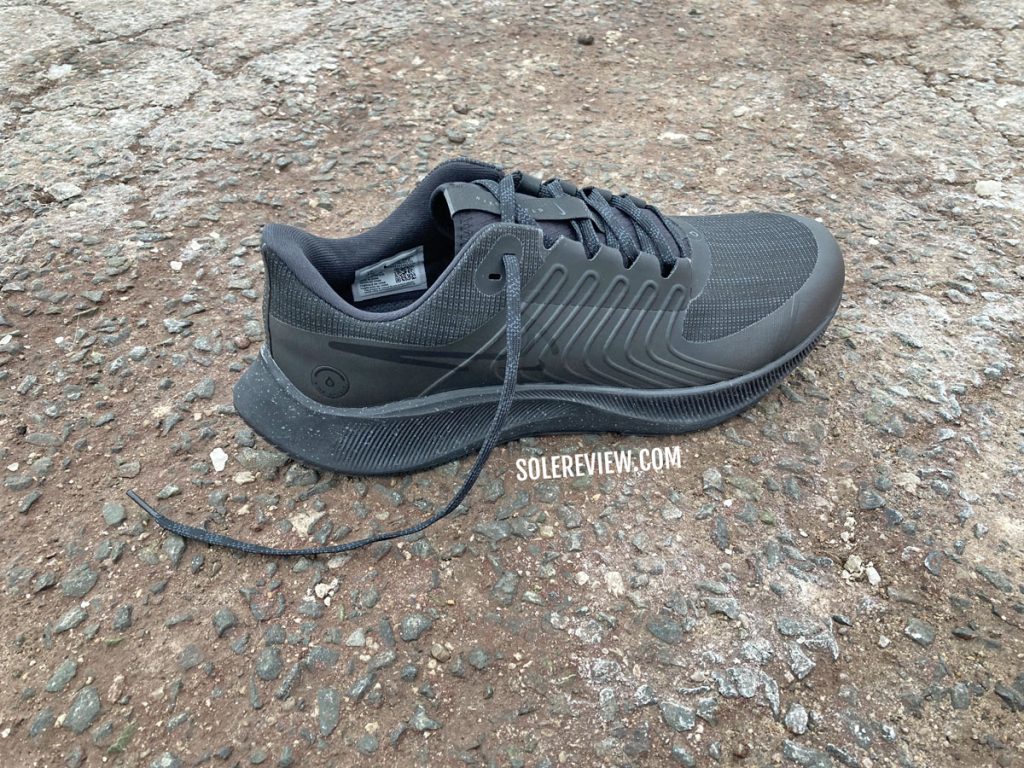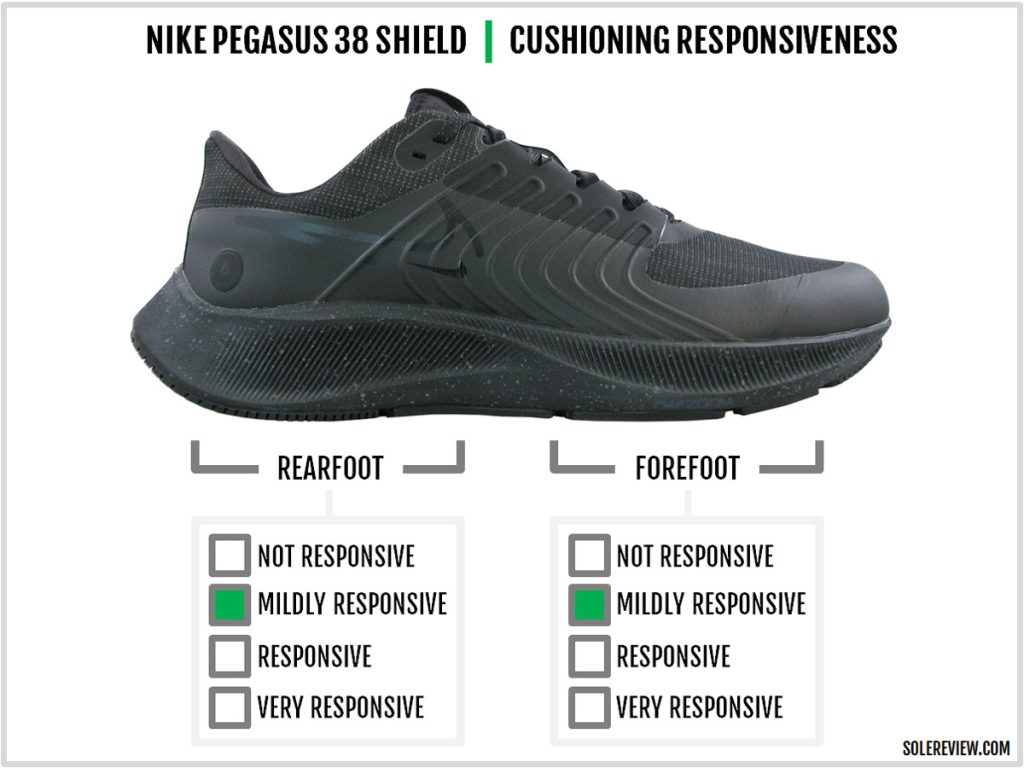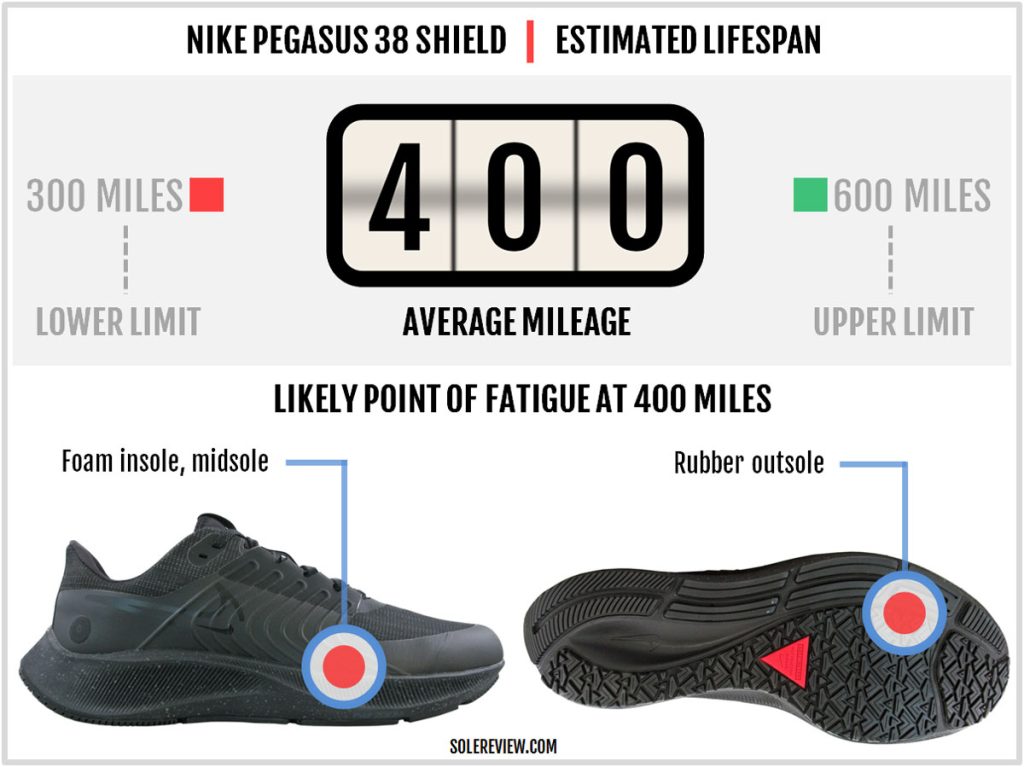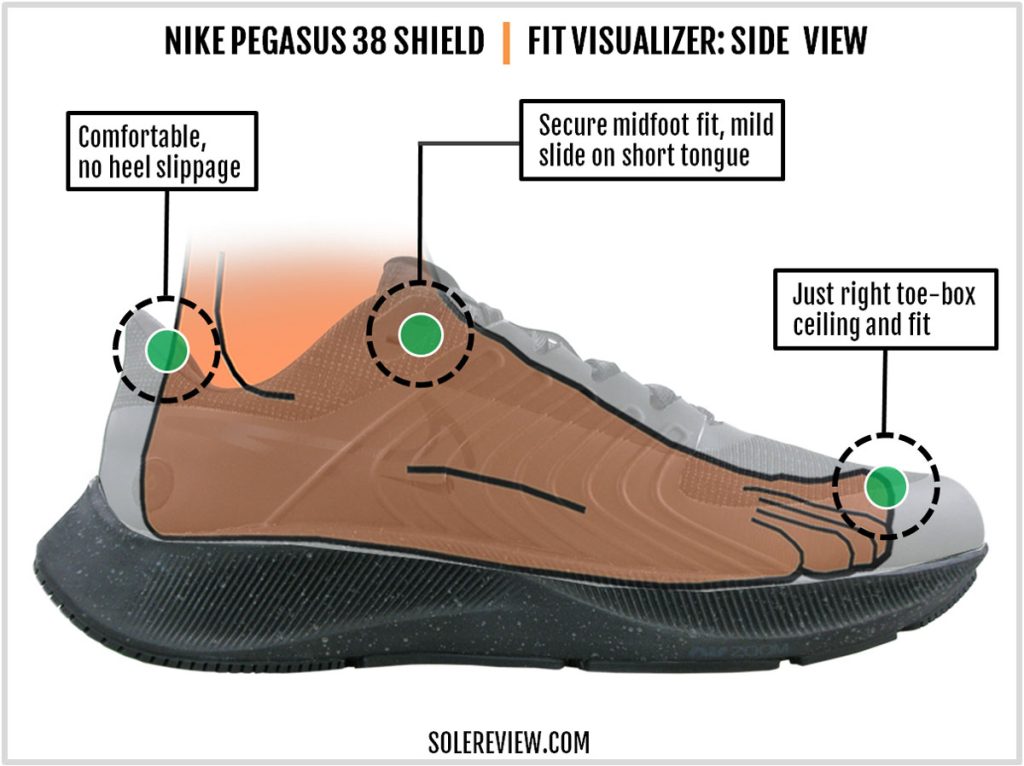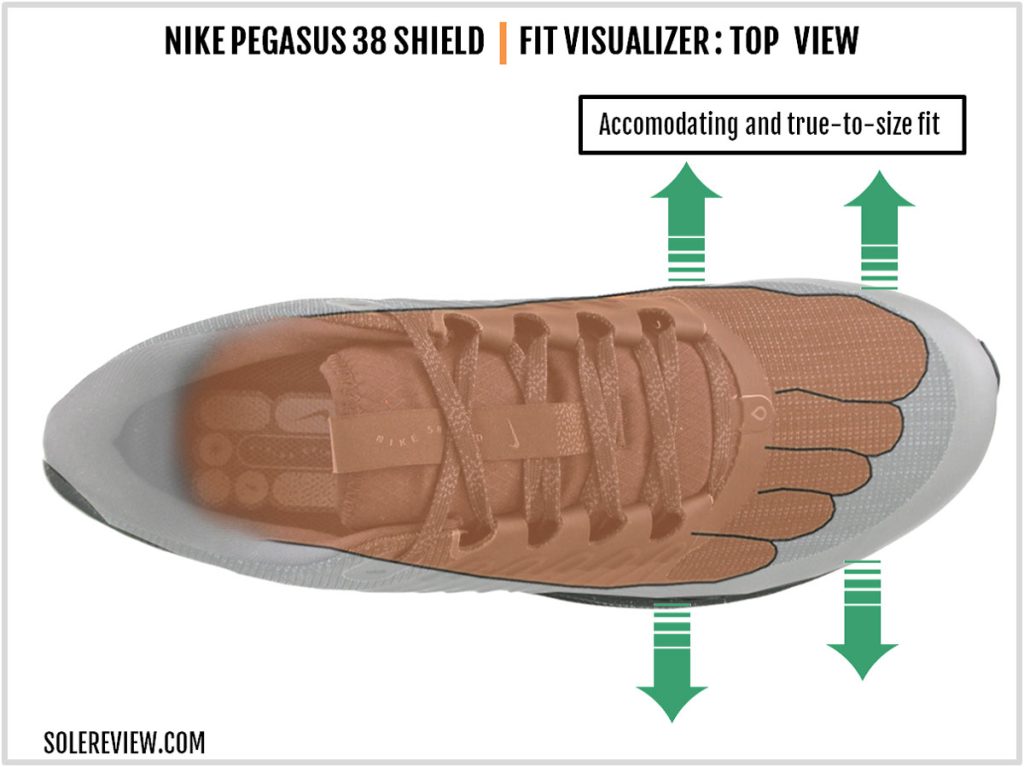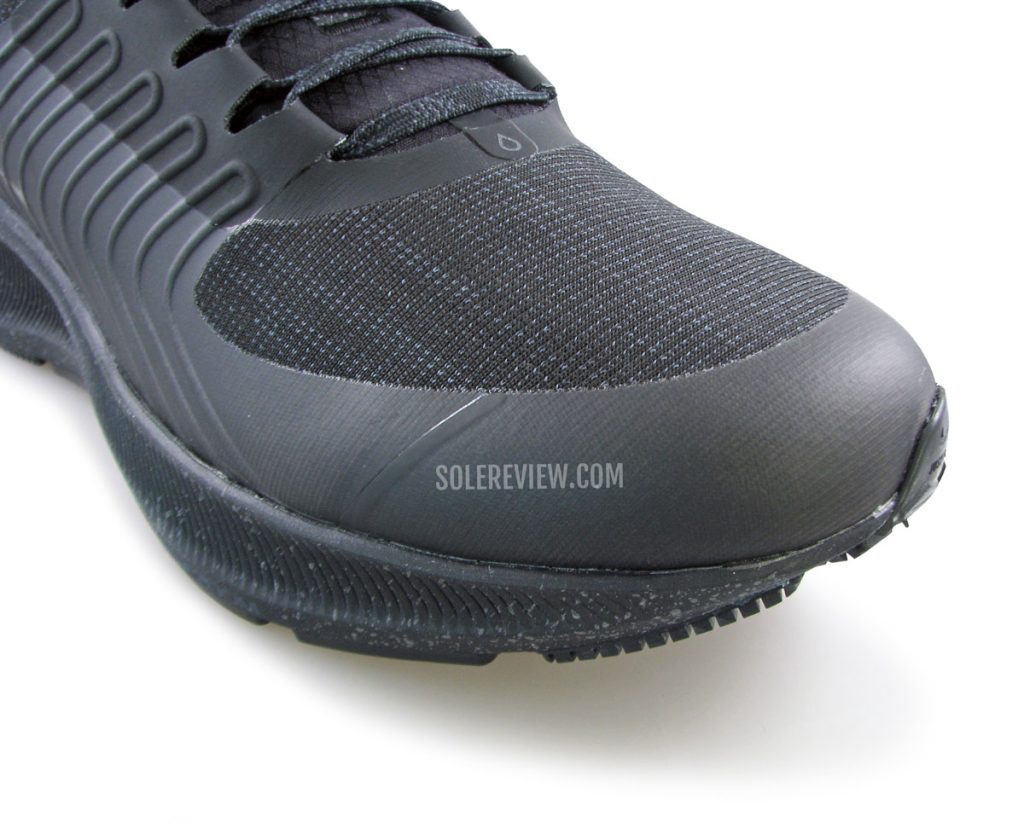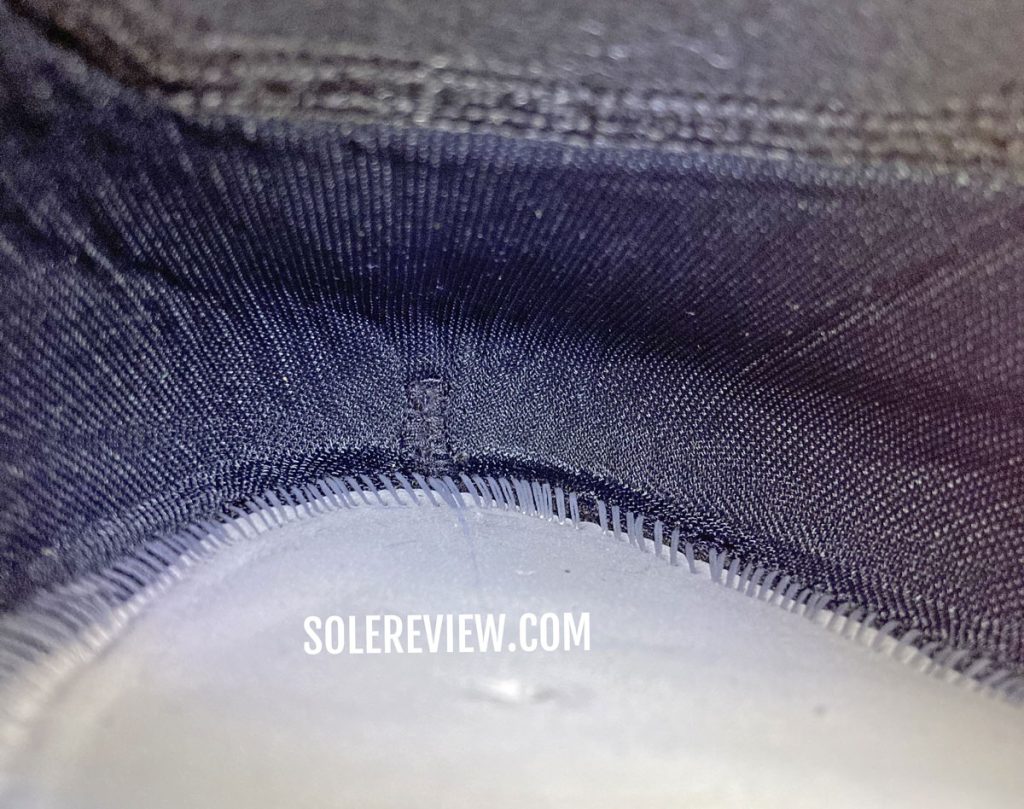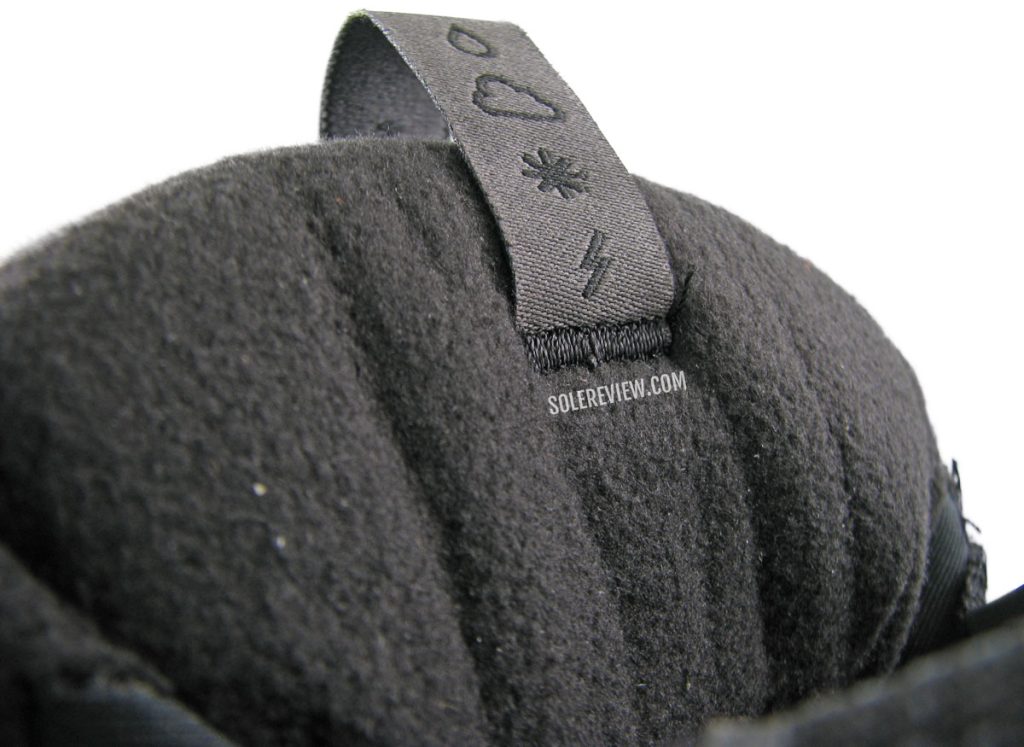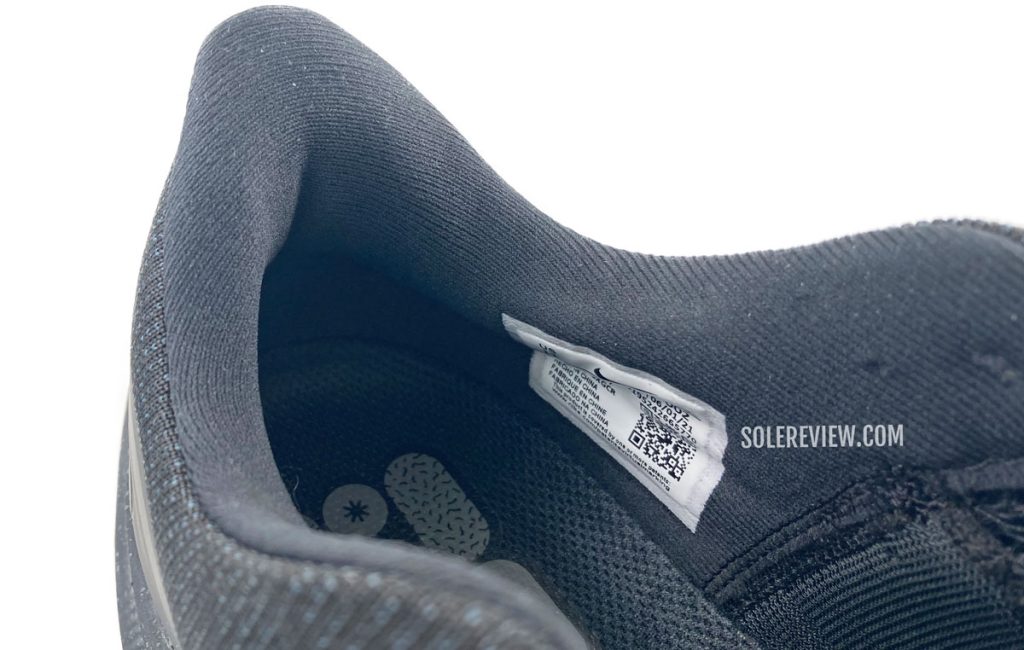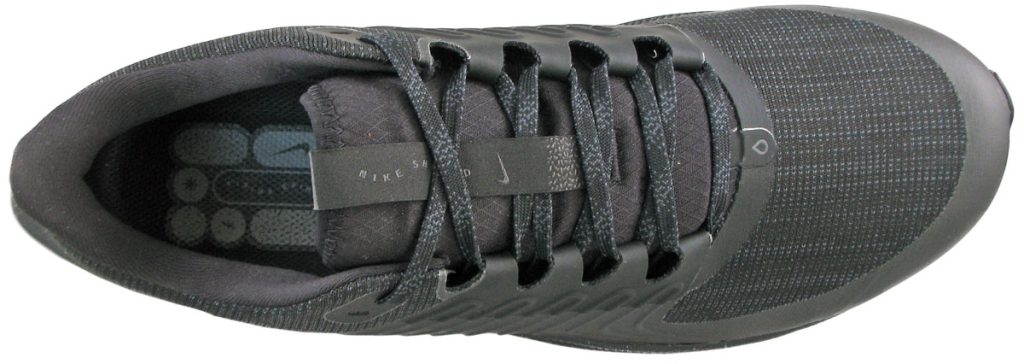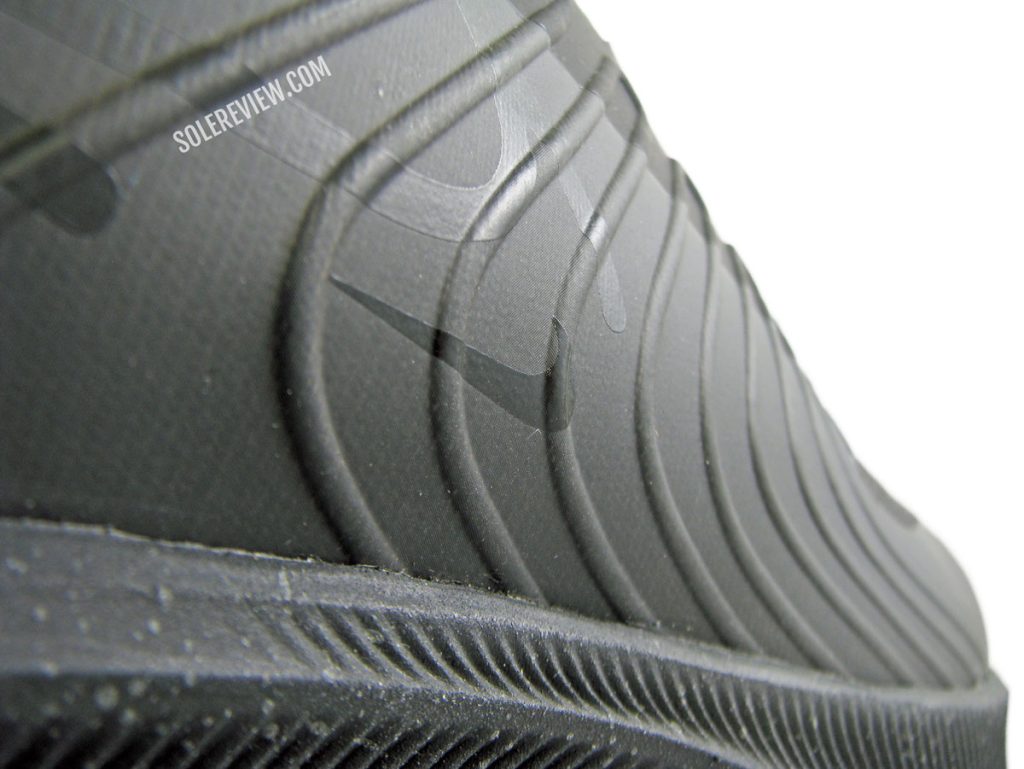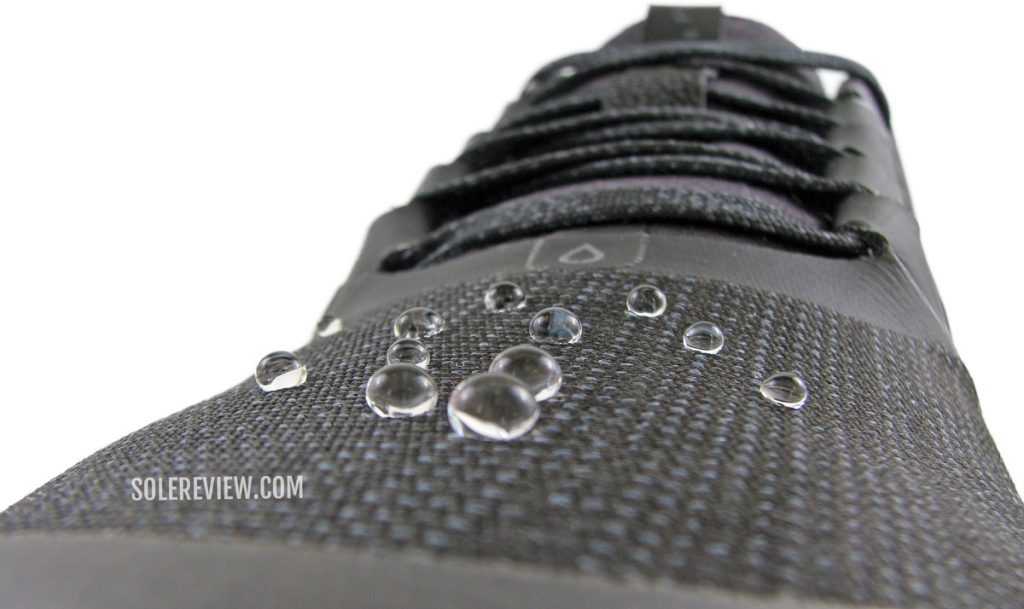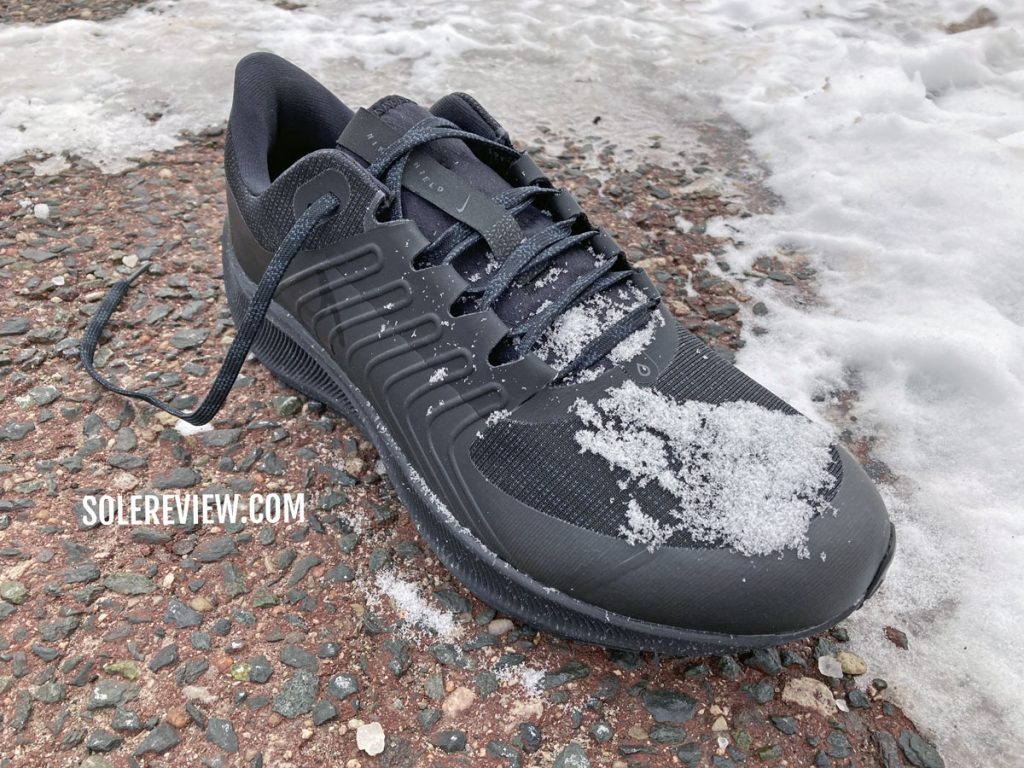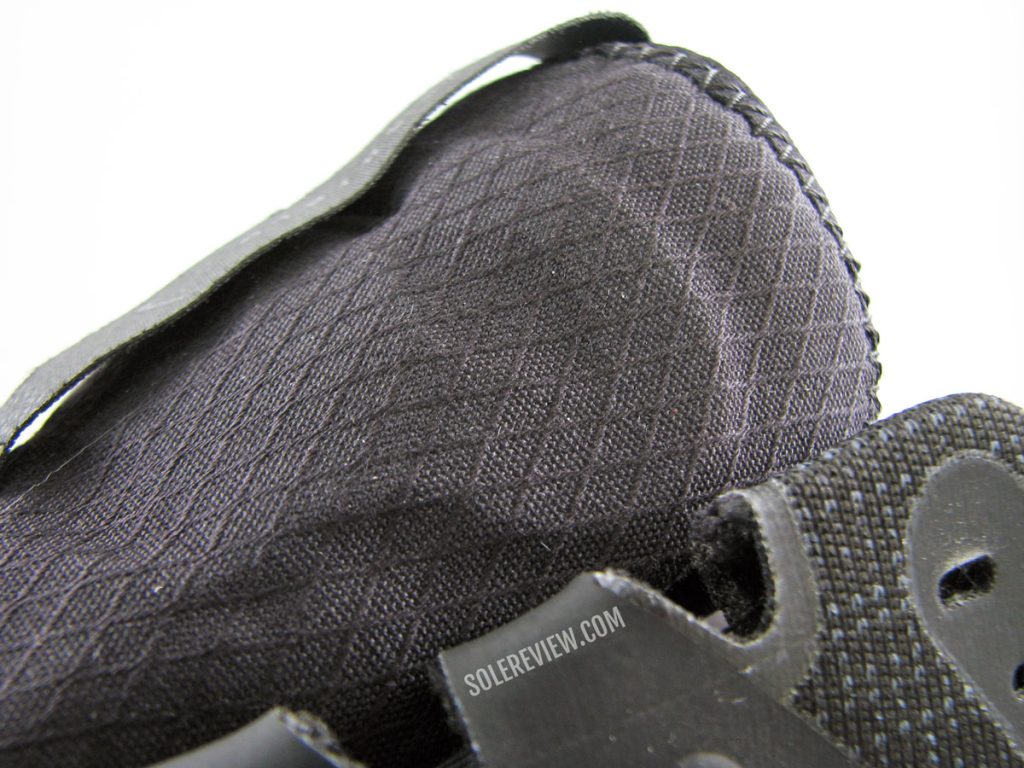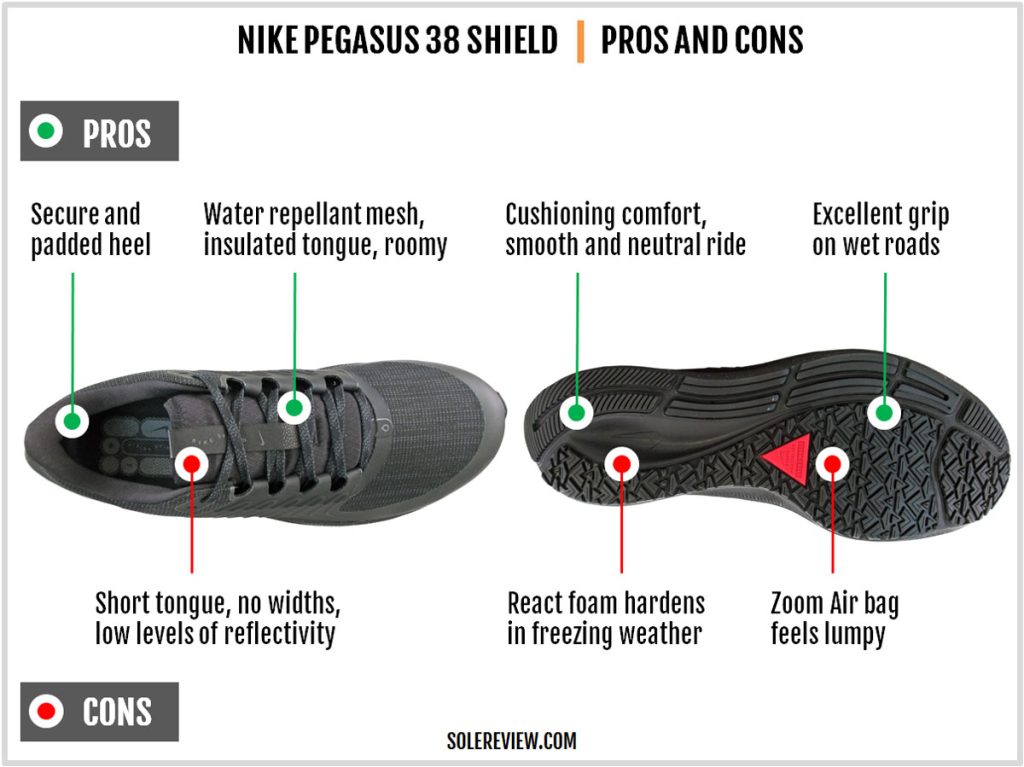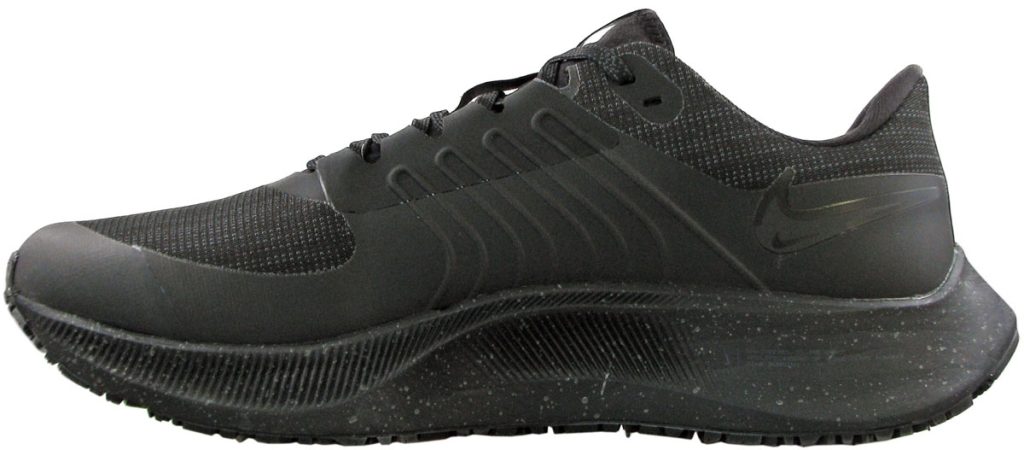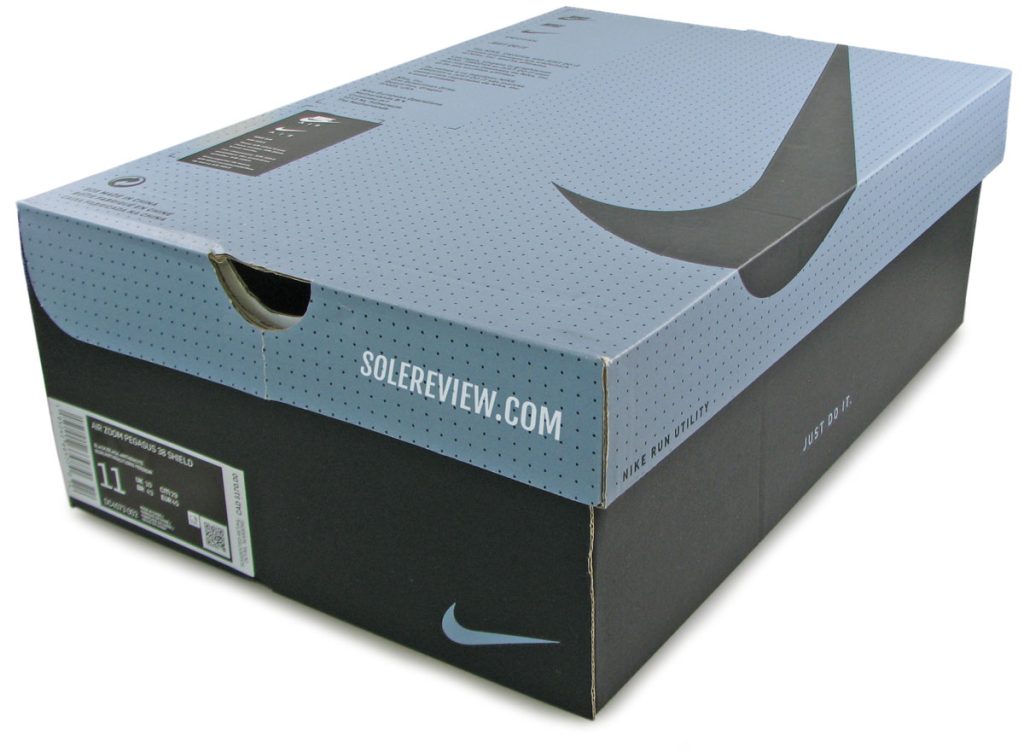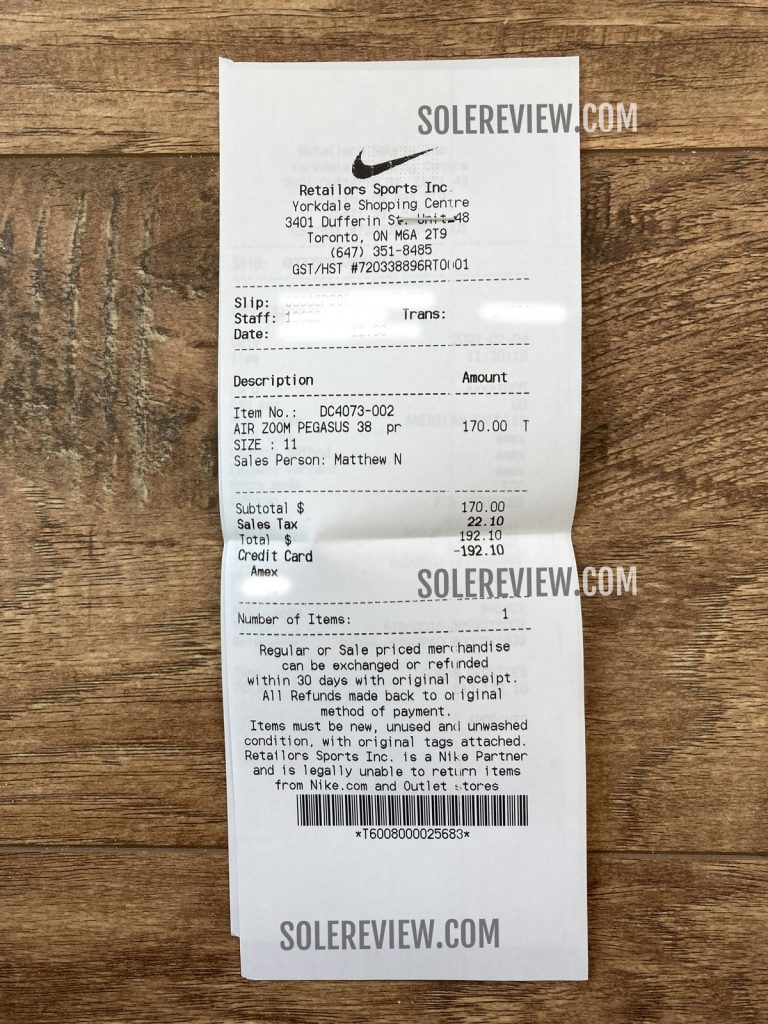
The Nike Pegasus 38 Shield was purchased at full retail price for our review. The amount is in Canadian Dollars.
INTRODUCTION
Nike’s running shoe catalog is constantly churning, but the brand has been consistent with its annual ‘Shield’ assortment. Our first review of a Nike Shield product was over a decade ago, and here we are again.
Like clockwork, the winterized versions of Nike’s popular models close to November each year. And what exactly sets apart a ‘Shield’ edition from its standard summer version?
Broadly speaking, a Shield model has four things that the regular version does not.
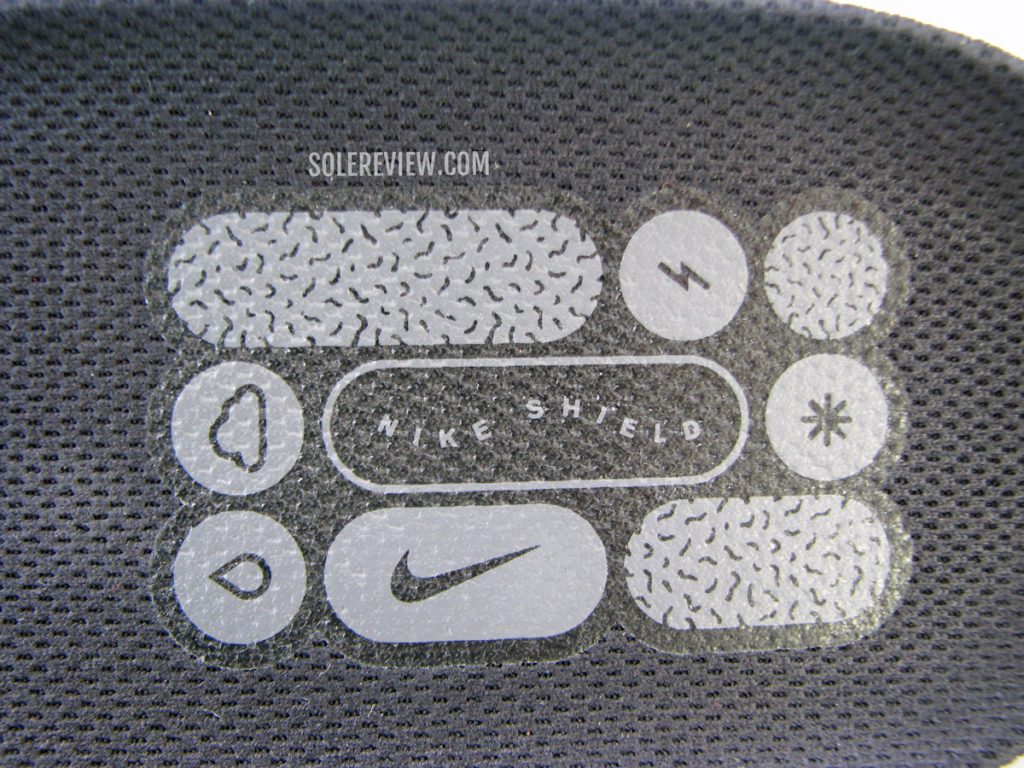
The graphic on the footbed is suggestive of Nike Shield’s feature-set. Ironically, reflectivity (represented by the graphic that resembles squiggly germs) is nearly absent on the Pegasus Shield.
Firstly, the upper is highly water-resistant. Two, the mesh shell is supposed to keep the feet warm during the colder months. The outsole material and geometry are also repurposed to meet the traction requirements for wet roads.
Lastly, the Shield collection is supposed to be more reflective than a comparable non-Shield shoe. However, that’s not always the case.
For the 2021-22 season, Nike sells three Shield models – the Pegasus 38, React Miler 2, and Winflo 8.
Out of the three, the Pegasus Shield offers the best balance between different performance traits. It’s cushioned, protective, durable, and has an accommodating fit that will take even thick wool running socks.
Though competing brands like adidas, Asics, Brooks, and Saucony sell winterized versions of their popular models, the Nike Pegasus 38 Shield is our favorite winter-running shoe. The upper does a respectable job of blocking the water and cold, and the outsole grip is a cut above the rest.
The only drawback is the abysmally low level of reflectivity, which is strange for a running shoe that’s intended for the darker months.
THE RIDE EXPERIENCE
The road versions of the Pegasus 37 and 38 share the same midsole and outsole, and it’s no different for the Pegasus Shield. A forefoot Zoom Air bag resides inside a React foam core to deliver a predictable ride experience that’s nearly identical to the Pegasus 37.
Even though the Pegasus 37 and 38 share the same midsole, the 38 uses a firmer density of the React foam.
A firmer React core works well for several reasons.
From a cushioning point of view, a firm density is a better match with the tightly-sprung Zoom Air bag. So even though there’s a slightly lumpy sensation under the forefoot, it’s not as pronounced as the softer Pegasus 37.
Having a firm midsole bodes well for the ride stability and quality of transitions. The gait cycle has a quicker turnover, and the low levels of compression makes the ride more supportive.
And just like the Pegasus 37, the 38 Shield’s midsole has a prominent flare to produce a sensation of under-arch support.
Sure, there are other transition-friendly features like the under-heel cavity and articulated ‘crash rail’ outsole.
But at the heart of any transition-friendly is a firm midsole with a uniform sense of cushioning, and that’s where the Pegasus 38 Shield does remarkably well.
Also, Nike React foam turns firmer in freezing temperatures – we called this in our review of the first Nike shoe with React, and more recently, in our review of the Pegasus Trail 3.
Here, since the base configuration is fairly firm to begin with, the difference between room temperature React and freezing winter React isn’t as stark as the softer Pegasus Trail 3.
Having said that, the removable insole and foam lasting create a comfortable layer of step-in comfort.
The molded footbed is made of soft blown foam that’s similar to an Ortholite material.
The Pegasus 38 Shield’s outsole (which is the same as the 37 Shield) is excellent.
It’s made of a tacky rubber compound that’s aptly named ‘Storm-Tread’. And it’s not just about the material; the unusual geometry also plays an important part in the traction delivery.
Unlike many winter shoes that use large lugs with a lot of negative space between them, the Pegasus 38 Shield’s outsole relies on a dense colony of tightly-knit lugs. This maximizes the contact area during the gait cycle.
A tenacious outsole grip is always good for transition efficiency. Landings and take-offs benefit from a grippy outsole, as that facilitates an efficient transfer of power to the road.
There’s a reason why racing flats often use a similar geometry to make the outsole as efficient as possible.
The Nike Storm-Tread outsole has an excellent grip on wet roads. Like any other rubber outsole, ice and snow-covered surfaces are to be avoided; the Storm-Tread is of little use under those circumstances.
The closely-spaced lugs also mean that the Pegasus 38 Shield is strictly a road shoe. Off-road use will quickly clog the outsole, so you’re better served with a road-trail hybrid like the Pegasus Trail 3.
Summing up the ride quality isn’t hard. The Pegasus 38 Shield’s well-rounded ride manners are versatile enough for many use cases.
It’s got adequate ride comfort for daily winter runs and endurance sessions alike. The added firmness and outsole grip also make the midsole tempo-friendly.
A few closing thoughts before we wrap up this section.
We think it’s a good time to retire the Zoom Air bag. It has served its purpose, and well. Cushioning inserts made a lot of sense during the era of blocky Polyurethane and go-flat EVA foam midsoles.
Today, the footwear industry has access to a wide range of cushioning materials that are far superior to traditional inserts. Nike, in particular, has ZoomX which has been used with great success in the Pegasus Turbo and Vomero.
Zoom Air sounds cool, but it no longer adds performance value. And since an embedded Zoom Air isn’t visible (unless Solereview cuts the shoe open) from the outside, nobody is going to miss it anyway.
IS THE NIKE PEGASUS 38 SHIELD DURABLE?
The upper is very well put together, the durable synthetic splash-guards and thick mesh see to that. Even the React midsole is firmer than before, and that slows the cushioning loss.
Based on our experience, even soft insoles – like the kind that the Pegasus 38 has – last a very long time before they go completely flat.
Finally, though the ‘Storm-Tread’ outsole rubber is soft, its compact layout means that the wear and tear are distributed evenly. We haven’t noticed significant wear on our pair 50 miles in.
A median lifespan of 400 miles sounds about right.
THE UPPER DESIGN AND FIT
Nike has nailed the fit of the Pegasus 38 Shield; it’s nearly perfect.
The broad forefoot has plenty of splay room for the toes. It’s also spacious enough to accommodate thick wool running socks that most runners will likely use during winter.
The interiors are very comfortable due to the soft and smooth lining with a thin layer of padding. The reverse side of the tongue has a thin layer of fleece for insulation; this makes the interiors soft.
And like any running shoe that’s supposed to be water-resistant, the upper has an inner sleeve. In the rear, a padded heel collar creates a comfortable yet secure fit.
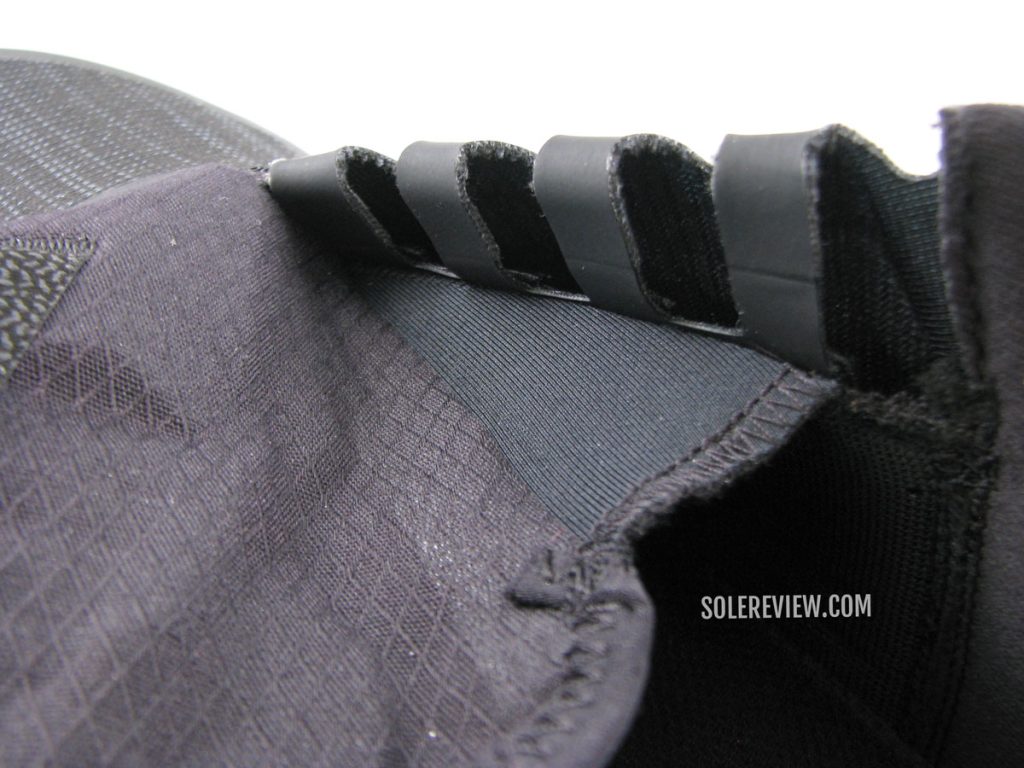
Most of the lacing happens via these speed loops. An internal gusset helps keep the cold and moisture out.
The midfoot design is also well executed. Except for the last row, the lacing is secured through speed loops that are a part of the midfoot panel.
The latter has molded details that act as a supportive structure. The ‘ribs’ also add design depth to what is a flat upper surface.
When running on wet roads, the first part of a shoe that gets soaked is the toe-box. Here, the Pegasus Shield is well protected.
The mesh with the DWR (Durable Water Repellant) surface treatment beads water, and there’s a PU coating on the underside. This shiny coating can be seen behind the speed lacing loops on the midfoot.
And it’s not just the mesh that repels water. The fused mud-guards on the lower half of the upper completely blocks the water and wind. The smooth upper is also very easy to wipe clean after a messy run.
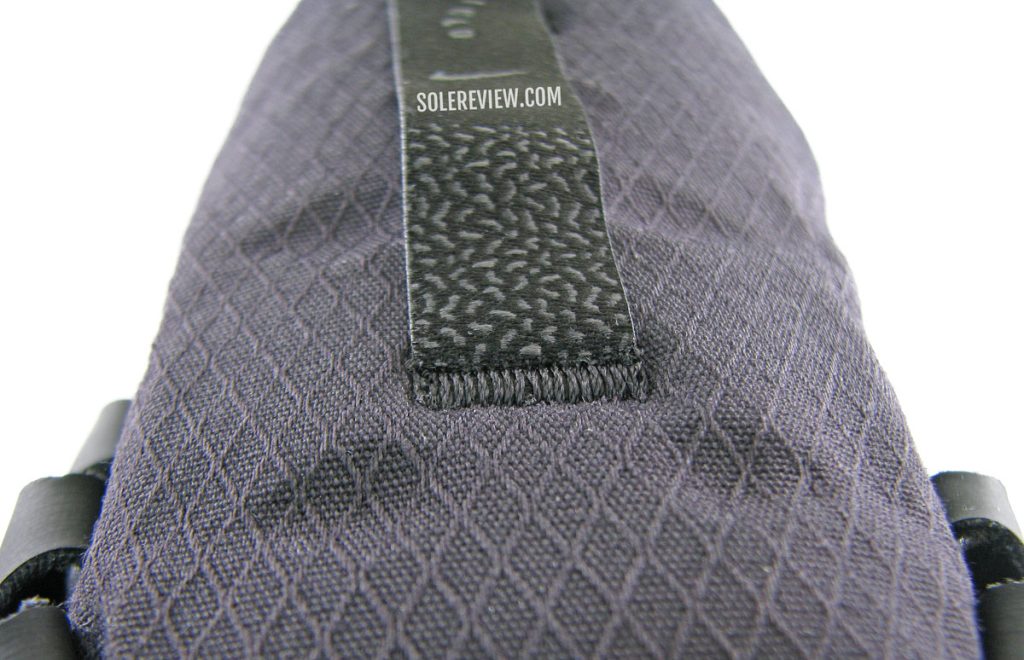
The ripstop mesh doesn’t appear to be DWR-treated, but offers reasonable water resistance. The ‘dimples’ on the tongue are the underlying cut-outs for ventilation.
Though the tongue isn’t coated with the DWR finish, the ripstop mesh has a fair degree of inherent water resistance.
The tongue plays a significant part in keeping the feet warm as well as elevating the level of comfort.
We have tested the Pegasus 38 Shield under various winter conditions, and the shoe’s sweet spot is -5 C ( 23 F) with thin wool socks, and -10 C ( 14 F) with thick woolen socks. We recommend getting a Smartwool or Icebreaker (our choice) running socks.
Just know that there’s no gaiter attachment point on the upper. And even if a gaiter was attached to the first lacing row, there’s insufficient ground clearance under the midsole to secure the loop or strap.
(Related read: The best running shoes for winter.)
There’s a foam insert within the tongue, and it’s perforated to keep the foot ventilated. The ‘dimple’ and foam outline are visible in our picture of the tongue flap; this padding also does a good job of filtering the lacing pressure.
We found the tongue a mite short, so employing the last lacing rock (runner’s loop) will lead to some crowding over the flap.
For an otherwise excellent winter running shoe, there’s a surprisingly low amount of reflectivity. On the upper, only a tiny logo on the forefoot and heel strap are reflective. That barely makes a dent in low light visibility.
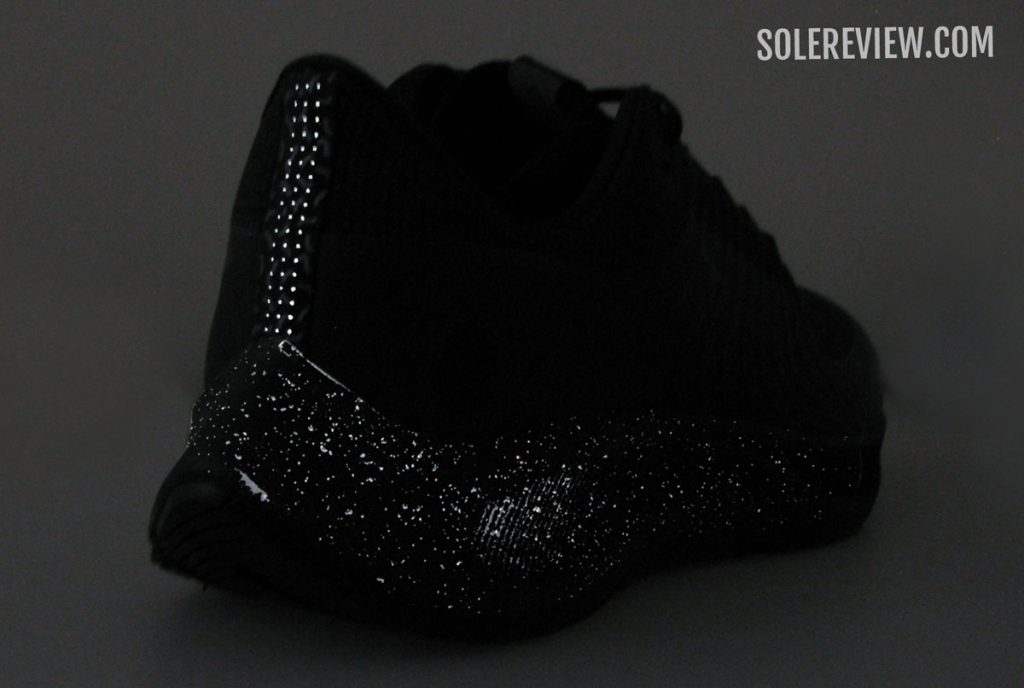
There’s very little reflectivity on the Pegasus 38 Shield. The reflective specks on the midsole are soon covered by winter slush and road salt.
Instead of using reflective trims on the upper, the midsole includes specks of shiny material.
In theory, it sounds workable. But it’s a bad idea. Because by the time the shoe is 30 miles in, a thin coat of dried-up road salt and slush splashes obscures the shiny bits.
There’s a good reason why most running shoes place their high-visibility trims on the heel, midfoot, or toe-box. The midfoot panel or large heel cutouts are the most effective placement positions for reflectivity.
Even having a set of reflective laces would have improved the Pegasus 38 Shield’s visibility in the dark.
(Related read: The most reflective running shoes.)
PROS AND CONS
The Pegasus 38 Shield has most of the ingredients that make a capable winter running shoe. The outsole grip is superb, and the insulated upper is water-resistant. It shares the same midsole with the standard model, so there’s plenty of cushioning for
It’s not perfect. Strangely, the upper has extremely low levels of reflectivity for a Shield model. The Zoom Air forefoot doesn’t feel like an integral part of the midsole, and the React cushioning is temperature dependent.
THE NIKE PEGASUS 38 SHIELD VERSUS PEGASUS 37 SHIELD
All the design updates take place on the Pegasus 38’s upper, as both the models use an identical sole. We prefer the 38’s simpler upper, as it’s much easier to cinch.
The Pegasus 37 Shield had a shroud over the first two rows of lacing, as well as a thin racer-like tongue flap. It also lacked the speed loops that makes lacing the Pegasus 38 easier, and the soft insulation was also absent.
In short, the 38 Shield is the better winter shoe of the two.
SHOES SIMILAR TO THE NIKE PEGASUS 38 SHIELD
Nike may have been the first brand to consistently offer a winterized running shoe collection, but other brands have since caught up.
The Asics Cumulus 23 AWL (All Winter Long) has a water-repellant upper, high-visibility details, and a grippy outsole. Like the Pegasus Shield, the Asics Cumulus AWL has a fused toe-bumper. The lacing is toggle-based for ease of use with gloved hands.
Saucony sells two categories of running shoes for the darker and colder months. The Runshield variants have a water-repellant and insulated upper, whereas the Vizipro models focus on high-visibility design elements.
In the context of the Pegasus 38 Shield, the similarly-named Saucony Ride 14 Runshield is a comparable shoe. That being said, it lacks a winterized outsole. The Saucony Peregrine ICE also isn’t a bad winter shoe, even though its outsole performance on icy roads is average.
Brooks’s winter running shoe game is weak. They have reflective colors in some of their staples like the Ghost, but they don’t get the full winter treatment.
The adidas Supernova Cold.RDY is a lower-priced winter running shoe with a base level trim.
Do you own this shoe? Improve this review by sharing your insights – submit a review here.

